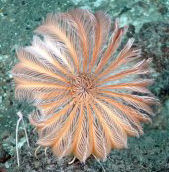
Crinoids
Crinoids live in the sea. Their name is derived from krinoeides (Greek) which means 'like a lily'. They are also called sea lilies or feather-stars.
|
Kingdom: Animalia Phylum: Echinodermata Subphylum: Crinozoa Class: Crinoidea |

| Crinoids are animals despite their name. They are related to starfish and echinoids. These often have 5 fold symmetry. The photo on the left shows the inside of a crenoid stem. You can see the hole is a a five pointed star. |
The crinoid is the state fossil of Missouri, USA.















